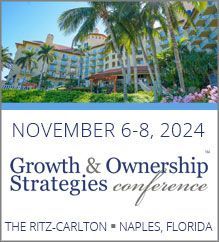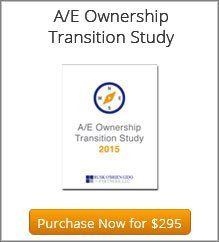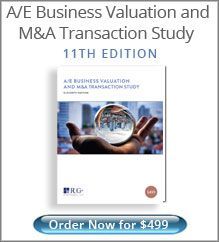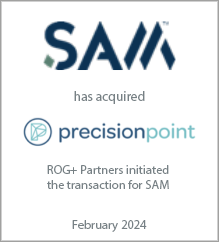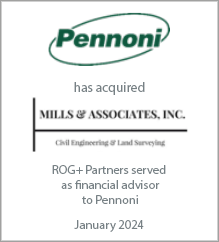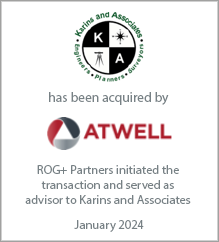Steve Gido specializes in corporate financial advisory services with a focus on mergers and acquisitions. Steve has assisted architecture, engineering, environmental consulting and construction firms of all sizes across North America achieve their growth or liquidity goals through successful mergers & acquisitions. Steve has over 15 years of investment banking experience and holds the chartered financial analyst (CFA) designation from the CFA Institute.
The Vanishing Mid-Sized A/E Firm
The Vanishing Mid-Sized A/E Firm
November 10, 2011
“We’re too big to be little, and we’re too little to be big.” – Burt Hill’s CEO Pete Moriarty on his board’s decision to sell to Stantec in 2010
Being stuck in the middle can be hard. In my mind, no one personified that dilemma better than Jan Brady, the perpetually awkward and insecure middle child on the classic TV series The Brady Bunch. On one hand, Jan was always jealous of her pretty and popular older sister Marcia, leading to unfair comparisons and inferiority complexes. And on the other, the family seemed to shower more affection on little Cindy, the sweet and talented youngest daughter, complete with her pigtails and cute lisp. If Jan wasn’t battling freckles, she was nervous about wearing glasses. As best as she tried to make a name for herself or form her own identity, Jan struggled to fit in.
You could draw similar comparisons to many mid-sized A/E and environmental consulting firms in this climate. From our vantage point, more of these “in-between” firms are struggling to fit in (and survive!) as well, leading to increasing numbers selling to larger national and international players (see table). While many leaders have sensed and observed this trend over the years, the underlying factors driving this phenomenon are unlikely to subside anytime soon.
The Middle Class
The initial question is just what exactly constitutes a “mid-sized” A/E firm, and in talking to industry leaders and experts you’ll find no shortage of opinions. Given the fragmented nature of an industry with thousands of niche practices, some define firms as “mid-sized” if they have 25 to 50 employees, particularly those that are single-discipline or dominate a particular city or region. Other companies, such as Halcrow (6,000 staff) and PBS&J (3,900), lamented their underwhelming size as motivation in selling out to industry titans CH2M HILL and Atkins, respectively. That’s a big range!
For simplicity’s sake, we’re going to define mid-sized firms as those with staff sizes between 150 and 1,500 employees. This would cover those organizations that comprise the ENR 500 up to approximately number 50. At a minimum, these firms have the following general characteristics:
Checking Out?
So why sell? In discussions with dozens of leaders of mid-sized organizations who sold over the last few years, the reasons they offered were the following:
Fighting the Tide
Fortunately, many firms aren’t quite ready to accept the inevitability of their predicament and simply get swept away with the winds of change. There are hundreds of resilient mid-sized firms who have survived through booms and busts, leadership changes, new competitors, and management fads. Recessions have a powerful way of honing the senses, and today more than ever, savvy leadership teams are challenging the conventional wisdom of business as usual as well as shaking up their firm cultures. Some of the bolder initiatives they are undertaking include:
Endgame
The A/E industry is going through some remarkable structural changes. The big keep getting bigger. Either displaced or just fed up, sole practitioners are putting out their own shingles in larger numbers. Design and consulting talent seems so readily available, yet so scarce. Unflinching clients are demanding more for less. The number of mid-sized firms is shrinking, but many are not going down without a fight.
Is your organization feeling a bit like Jan Brady today? Tell us what you think. ROG Partners brings years of seasoned financial and business experience in navigating A/E and environmental clients through strategic and ownership alternatives in an ever changing landscape.
You could draw similar comparisons to many mid-sized A/E and environmental consulting firms in this climate. From our vantage point, more of these “in-between” firms are struggling to fit in (and survive!) as well, leading to increasing numbers selling to larger national and international players (see table). While many leaders have sensed and observed this trend over the years, the underlying factors driving this phenomenon are unlikely to subside anytime soon.
The Middle Class
The initial question is just what exactly constitutes a “mid-sized” A/E firm, and in talking to industry leaders and experts you’ll find no shortage of opinions. Given the fragmented nature of an industry with thousands of niche practices, some define firms as “mid-sized” if they have 25 to 50 employees, particularly those that are single-discipline or dominate a particular city or region. Other companies, such as Halcrow (6,000 staff) and PBS&J (3,900), lamented their underwhelming size as motivation in selling out to industry titans CH2M HILL and Atkins, respectively. That’s a big range!
For simplicity’s sake, we’re going to define mid-sized firms as those with staff sizes between 150 and 1,500 employees. This would cover those organizations that comprise the ENR 500 up to approximately number 50. At a minimum, these firms have the following general characteristics:
- Multi-disciplined service offerings, typically including some combination of engineering, architecture, planning and/or environmental consulting
- Mix of public and private sector clients
- Anywhere from 5 to 50+ office locations, with activities often dominated in one state or several regional footprints
- Privately held, with ownership profiles ranging from sole owner to 100% ESOP
- Formal management structures, governance policies, and IT/financial reporting systems
Checking Out?
So why sell? In discussions with dozens of leaders of mid-sized organizations who sold over the last few years, the reasons they offered were the following:
- Higher valuation – it’s common to see mid-sized A/E firms sell stock internally at book value or other deeply discounted levels as a means of affordability and simplicity. Cash-rich publicly-traded buyers have the resources to offer much higher valuations, in many cases from 5 to 8 times operating earnings and 2 to 4 times book value. For baby boomer principals whose ownership stake is often the largest asset in their retirement portfolio, better to cash out sooner rather than later. Another factor for owners – future tax rates will be going in one direction – up!
- Ownership transition failure – the reality today is a large percentage of mid-size A/E firms have ownership profiles that defy logic. Many are “top heavy” with principals in their 50s and 60s who own a large majority of the stock. There simply aren’t enough 30 and 40 year-olds ready, willing, and able to buy these senior owners out in a coordinated process that won’t result in a decade (or more) long sell down. With profitability levels down, using the firm as a conduit to fund buyouts via cash bonuses for equity or other transfer mechanisms is increasingly difficult. More ominously, in a low growth environment, cash used to pay down redemption liabilities means less available for firm reinvestment, incentive compensation, and growth capital.
- Leadership succession failure – hand-in-hand with ownership transition challenges are leadership succession ones. Aging A/E leaders haven’t done nearly enough to prepare and groom their next generation. Many presidents and principals look around and readily admit they don’t have faith that the next tier of managers has the capacity and acumen to guide them into the 21st century.
- Increasing client demands – the trend in A/E client delivery models has been towards more “one stop shopping” and offering end-to-end solutions from multi-discipline planning and design through construction and monitoring. Larger firms often have the geographic coverage, broader service offerings, and business development resources that many mid-sized firms lack.
- Diminishing marginal returns – mid-sized firm leaders voiced their frustration with the steady creeping of corporate overhead, bureaucracy, fixed costs, branch offices, governance policies, and slower decision making, all of which served to produce lower shareholder returns! In contrast, small, niche firms had lower cost structures, were more operationally nimble, and can often focus on one discipline, market segment, or geographic area more effectively.
Fighting the Tide
Fortunately, many firms aren’t quite ready to accept the inevitability of their predicament and simply get swept away with the winds of change. There are hundreds of resilient mid-sized firms who have survived through booms and busts, leadership changes, new competitors, and management fads. Recessions have a powerful way of honing the senses, and today more than ever, savvy leadership teams are challenging the conventional wisdom of business as usual as well as shaking up their firm cultures. Some of the bolder initiatives they are undertaking include:
- Regional combinations – mid-sized firms experiencing similar growth or ownership challenges are coming together to create larger regional engineering or architecture organizations for sustainability and growth. Good examples are H.W. Lochner and Bucher, Willis & Ratliff joining forces in the Midwest, and Pennoni linking with Patton Harris Rust in the Mid-Atlantic. Architecture firm “merger of equals” are developing around common urban centers as well.
- New ownership models – faced with sizable redemption liabilities, some organizations with conventional owner/partner models are considering new avenues, including implementing Employee Stock Ownership Plans (ESOPs) or Employee Stock Purchase Plans (ESPPs). Studies have shown that broad-based employee ownership, combined with open book management and other participative measures, can be a strong impetus to growth and profitability. Private equity is another model, where growth-oriented financial investors can help with a partial exit strategy for owners while injecting capital and business expertise to accelerate growth.
- Intentional shrinking – most A/E firms are smaller than they were five years ago, and many significantly so. Lower project volumes have led to a combination of layoffs, office closings, divestitures, and a strategic culling of clients. As a result, many leaders offer that they are “leaner and meaner” than they have been in years and are more focused at a reduced size.
- Get growing – for all the hand wringing and tales of woe in the A/E industry, trust us that there are a number of great growth stories taking place every day. Mid-sized firms that are “bucking the trend” are doing it through taking a critical evaluation of their business development and marketing practices, aggressively pursuing new markets and client verticals, acquiring niche firms themselves, bringing in outside talent at all levels, and taking market share away in a lower growth environment. It’s refreshing to see!
Endgame
The A/E industry is going through some remarkable structural changes. The big keep getting bigger. Either displaced or just fed up, sole practitioners are putting out their own shingles in larger numbers. Design and consulting talent seems so readily available, yet so scarce. Unflinching clients are demanding more for less. The number of mid-sized firms is shrinking, but many are not going down without a fight.
Is your organization feeling a bit like Jan Brady today? Tell us what you think. ROG Partners brings years of seasoned financial and business experience in navigating A/E and environmental clients through strategic and ownership alternatives in an ever changing landscape.
Table: Representative Mid-Sized A/E and Environmental Consulting Transactions, 2010-2011
Latest Perspective
Perfecting the A/E Exit Strategy – Five Key Factors
An enormous A/E generation that kicked off their careers in the 1980s and subsequently started firms or became owners in the 1990s ...
© 2024
Rusk O'Brien Gido + Partners, LLC
Financial Experts for Architects, Engineers, and Environmental Consulting Firms



